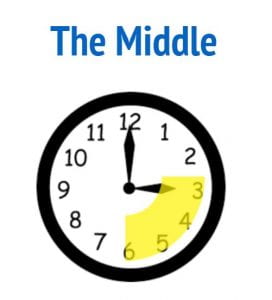What is the theory of small teaching?
The theory of ‘small teaching’ comes to us from James Lang (2016). He asserts that small teaching is the minor changes to course design, assessment structure, or communication with students that impact student engagement, motivation, and achievement. His book Small Teaching: Everyday Lessons from the Science of Learning organizes these small changes into three categories – knowledge, understanding, and inspiration. We can also look at the small changes as techniques that can be implemented into individual class sessions at the beginning (in the first fifteen minutes), in the middle, or at the end (in the last fifteen minutes). This series of posts will share small teaching techniques to implement in these sections of a course session – the beginning, middle, and end. Below we will discuss different techniques to use in the middle of a class session. Click here to see the first post on techniques to implement in the first fifteen minutes.
The Middle of Class
It is important to take time during the middle of a class session to gauge student understanding. The research is conflicted on the average student attention span, but we encourage faculty to break their lectures into fifteen minute segments. Once content has been delivered for fifteen minutes, whether through lecture or other direct instruction method, we have an opportunity to engage in a formative assessment of student learning. Incorporating a formative assessment provides information that is not only critical to the faculty member but is also helpful to student learning. Karpicke and Blunt (2011) found that when students were tested on material, they were better able to recall that material in future re-tests. This ‘testing effect’ that they found asks students to practice retrieval of information which can lead to better recall in the future. Formative assessment techniques like the ones explained below ask students to stop and think about the material, helping to solidify the information into their memory. There are many formative assessment techniques that can be used. We have included three ideas below.
Self-Explaining
The first formative assessment technique asks students to self-explain their thinking. After discussing a topic, the faculty prompts students to self-explain their efforts to answer a question, solve a problem, or practice other intellectual skills. Self-explaining can be used with a common technique called Think-Pair-Share. The self-explaining formative assessment can begin with students jotting down a few sentences about their thinking. They can then be asked to turn to someone in the class to explain their thinking. This can then be followed up with a larger group discussion where students share what was discussed with the larger group. Students can also submit their self-explanation of their thinking via a quick poll or online interactive like Top Hat.
Connecting
The next formative assessment technique that can be used is connecting. After discussing a topic, faculty can prompt students to provide one or two examples of how the material connects to other class sessions, larger units, courses in their curriculum, current events, or real world application. Students can be asked to share these via a quick large group discussion or through an online submission. Asking the students to make connections between the class material and things of relevance to them can facilitate transfer of learning, an often forgotten aspect of teaching. Perkins (2009) argues that making connections and facilitation of transfer must be an intentional aspect of teaching in order to make the most of student learning.
Predicting
The last formative assessment technique to use in the middle of class is predicting. In this technique, faculty stop and ask students to speculate about possible solutions, answers, or ideas before full exposure to course content. This technique can be used in explaining a process or cyclical concept. The faculty explains the first steps of a process or cycle and then prompts students to predict what might be next. Even when students guess a wrong answer, they are more likely to remember the solution once it is revealed to them than if the whole process is simply explained to them.
To assess or not assess?
Much like the small teaching techniques presented in the first post, student responses can be collected or not collected. There are benefits for the student in just doing the activity, in practicing retrieval as mentioned at the beginning. Using the chat feature in Zoom or a platform like Top Hat to collect student responses to a question related to these activities can serve as an attendance tracker. Informally collecting student responses when utilizing these small teaching techniques are most useful to the instructor in that they provide a gauge of student understanding of material, which can inform future instructional decisions.
This post presented ideas to implement small teaching techniques into the middle of a class session. The next post will include ideas for the last fifteen minutes of class. If you would like to discuss ways to incorporate these ideas into your teaching, make an appointment with an Instructional Designer in the Center for Teaching and eLearning.
Finally, if you are seeking additional ideas for checking student understanding, visit this Edutopia Resource.
Instructional Designer, Dani McCauley, also presented a one hour webinar on small teaching techniques which was hosted by the Schreyer Institute of Teaching Excellence.
References
Karpicke, J. D., & Blunt, J. R. (2011). Retrieval practice produces more learning than elaborative studying with concept mapping. Science (American Association for the Advancement of Science), 331(6018), 772-775. https://doi.org/10.1126/science.1199327
Lang, J.M. (2015, November 15). Small changes in teaching: The minutes before class. The Chronicle of Higher Education. Retrieved February 11, 2021, from https://www.chronicle.com/article/small-changes-in-teaching-the-minutes-before-class/
Lang, J. M. (2016). Small teaching: Everyday lessons from the science of learning. Jossey-Bass.
Lang, J. (2020). Small teaching: From minor changes to major learning [Video]. https://live.libraries.psu.edu/Mediasite/Play/f169bddf458a455cae07850b5c8e14b21d?catalog=8376d4b24dd1457ea3bfe4cf9163feda21
Lang, J. (2020). Teaching distracted minds [Video]. https://live.libraries.psu.edu/Mediasite/Play/77c23163c9a24f31851fb4c0e74604341d?catalog=8376d4b24dd1457ea3bfe4cf9163feda21
Perkins, D. (2009). Making learning whole. Jossey-Bass.


